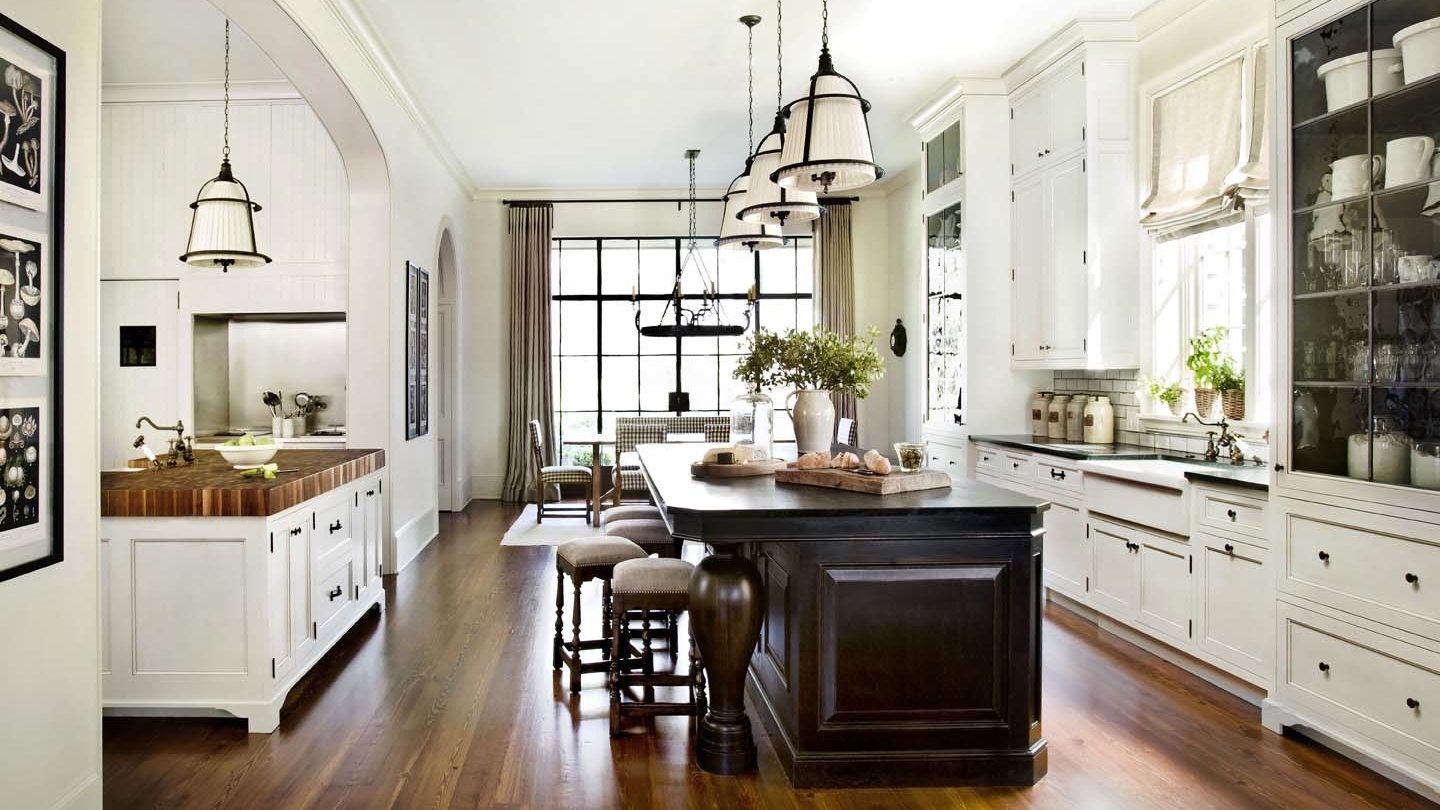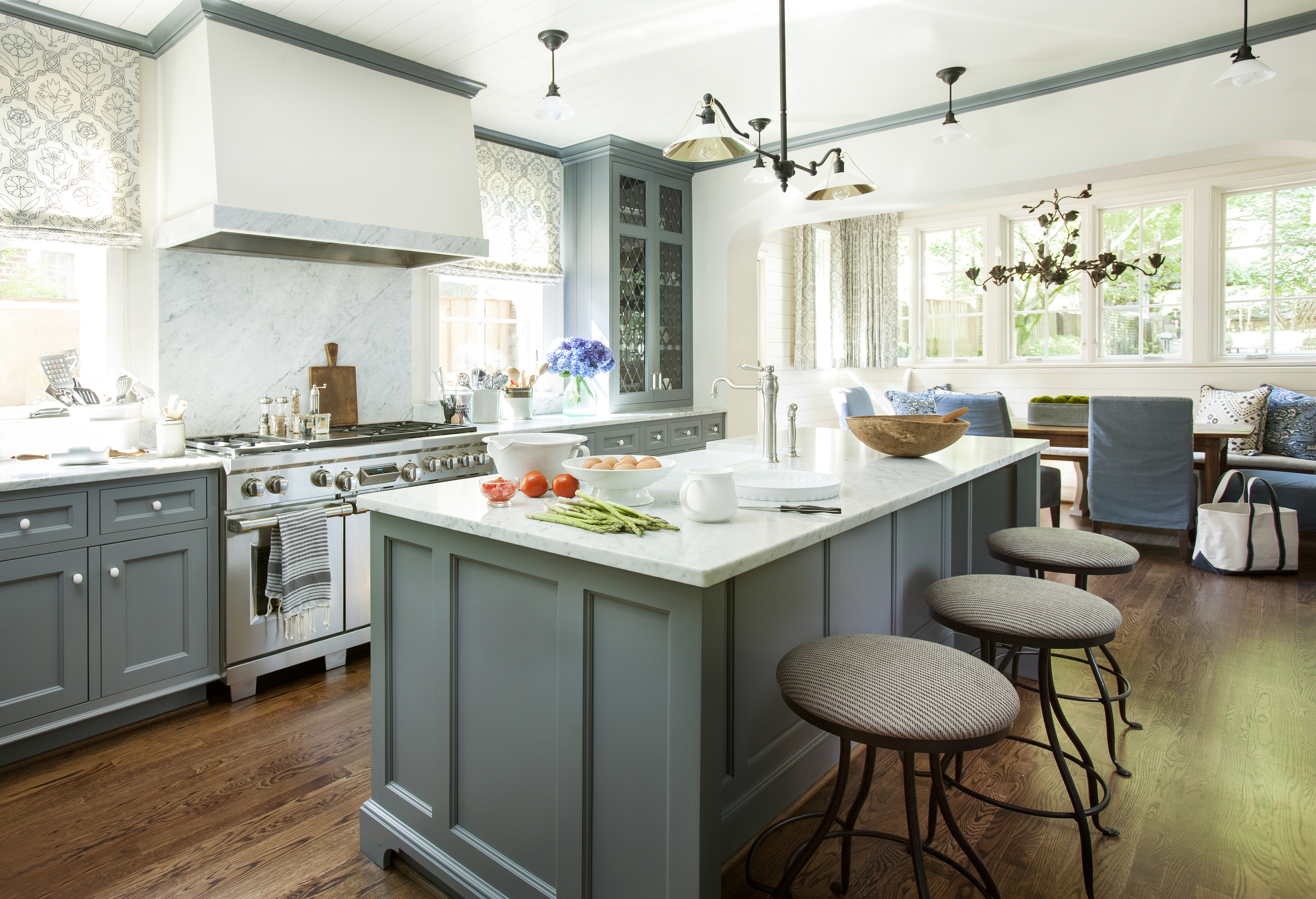The Kitchen Should Make You Smile
Three Important Lessons About Interior Design
Story by Chuck Reece | Photos by Erica George Dines
When I was asked to write a piece about Barbara Westbrook’s approach to kitchen design, I immediately thought of reasons why I wasn’t qualified. The largest and most obvious of those reasons was that I had never actually worked with a kitchen designer.
But then I figured that maybe there were two good reasons why I should write the story.
I am a journalist, and — at least in concept — a good journalist should always be able to tackle a story about subject matter he doesn’t initially understand. Also, I work with a designer every day in my job as the editor of a web-based magazine. By doing this, I’ve learned that designers need given room to work. They have skills different from mine, and I’ve come to know that by resisting the urge to dictate to the designer, the designer invariably produces better work. I was curious to see whether this same dynamic would be at work with Barbara.
But really, there was an even bigger reason: I cook. I love to cook. And in my head there exists a dream kitchen — a kitchen that would feel absolutely perfect, with spaces dedicated to the different functions of meal preparation, the chopping of vegetables, the carving of meats, the alchemy that happens on the stovetop, but also a place that would fit perfectly into the personality and character of my home. A place that would feel truly like the beating, functioning heart of my home, which is, after all, what God intended the kitchen to feel like.
So I decided it would be a fine idea to take my dream kitchen to Barbara Westbrook — to see what a seasoned expert might make of my ideas.
It was a fascinating experience. I learned some lessons.
Lesson No. 1:
No Kitchen Is an Island
(Although It Can Have One Inside It)
Barbara Westbrook isn’t a kitchen designer. At least not in the conventional sense.
Instead, Barbara is an interior designer, which means she is concerned with every interior space of a home — and therefore always aware of how the kitchen fits into the rest of any home’s interior environment.
“It always starts with the architecture,” Barbara told me. “If you have a client that’s building or restoring a Pennsylvania-style farmhouse, you know it’s going to be American in its feeling. It’s not going to have French, Italian or other European elements. It's going to have a defined American feel decoratively — in the details and the color palette and the materials because you want the exterior and the interior to play well together. It doesn't have to be literal interpretation; it just needs to feel American.”
Designing a kitchen, then, is never just an exercise about functionality (what you need to be able to do in the kitchen). It must also be an exercise in feeling. In short: Does the kitchen feel comfortable in the space it occupies, inside the larger design of the whole home?
Lesson No. 2:
A Kitchen Is More Than a Collection of “Features”
Because I happen to love cooking and making cocktails for friends, I assumed that taking my dream kitchen to Barbara would begin with two simple items:
• The dimensions of the space itself
• A list of the appliances and features my kitchen should have
I based the dimensions on the kitchen in one of my former homes — which was large enough to contain a highly functional yet welcoming kitchen, although it had been sorely in need of expert design help. But I had always loved the size of it and decided I’d approach Barbara with its dimensions as my model. As for the list of features, that was easy. It included the basics — refrigerator and freezer space, the need for a six-burner stove and two ovens — and it also encompassed a few of my own odd obsessions. A kitchen for a cocktail geek like me would require a lot of space for bottles to be displayed and maybe even a high-end ice machine like those used in upscale cocktail bars, the machines that make perfect, one-inch cubes of crystal-clear ice by the hundreds.
Barbara was happy to get both the dimensions and my list and told me both were important — but that they would become more important later in our process. Something more critical had to happen first. Barbara had to see the space for herself.
“I think it's important in any space to know how it feels when you stand in it,” Barbara said. “What is the ceiling height? Do some of the openings need to move or change? Where is the sunlight? From which way is it coming? It is also important from a decorative standpoint to identify the focal point. When you walk into the space, what are you looking at?”
When she told me this, I understood its importance immediately. An interior space is, to a skilled designer, as a canvas is to a painter — a fact that leads us directly to a third lesson.
Lesson No. 3:
Let the Artist Paint
To a client, the single most challenging part of working with a designer is mustering the ability to step back and let the designer work her magic.
As an editor working with a graphic designer, I’ve come to understand that the old cliche, “A picture is worth a thousand words,” is often quite literally true. The right image can make a thousand words — words that I’ve slaved over — unnecessary. Sometimes, it is difficult to make the choice to remove those words, but I’ve learned that the product of that choice is usually something greater than my words alone would have been able to achieve.
Therein lies the crux of the challenge for any client who works with a designer. There is a natural and understandable tendency for the client to think, “I have hired this designer to do X, Y and Z” — and to expect that X, Y and Z will therefore be done.
But the magic of working with a designer comes in letting go of your expectations about how X, Y and Z should be done.
Barbara proved this to me by using the monstrous ice machine that was part of my dream kitchen as an example. We looked at a picture of the specific ice machine I dreamed of, and Barbara looked at me and told me the truth: “It isn’t that pretty. I’d try to hide it in the pantry.”
She was right. As proud as I would be to have that machine of my dreams in my kitchen, the truth is it would make any guest feel they had walked into an industrial place — and not into a home. It became instantly clear to me — as clear as those ice cubes from my dream machine — that if I invited Barbara to help me build the kitchen of my dreams, I would be wise to let her knowledge and experience shape my dream on its way to fruition.
The Lessons in Practice
I wanted to see how Barbara’s approach to kitchen design plays out in the real world, so I asked her to take me to a real kitchen, in someone’s real house, that she had designed.
We visited a beautiful, farmhouse-style kitchen not too far from the Westbrook Interiors studio in Atlanta. Barbara had worked with the noted Atlanta architect Keith Summerour as the house was designed and built a little more than five years ago. The entire interior design of the house was Barbara’s work, and the value of her lesson about how the kitchen must “play well” with the rest of the home became immediately apparent when I walked in.
The design of the entire home followed the lines of an American farmhouse from the late 19th or early 20th century. If a woman from that time could have traveled a century forward to this home, she would not have immediately noticed anything unfamiliar. On one side of the kitchen, behind a large butcher-block counter, she would see a stove tucked into a structure fashioned from wood and plaster that looked for all the world like a hearth with a mantelpiece — just as an early 20th century wood stove would have been surrounded by a working hearth. She would have looked in the other direction and seen a simple farmhouse sink, positioned directly beneath a kitchen window that let in a view of a sunlit morning landscape.
All the conveniences, all the kitchen functionality that the enthusiastic cooks who live in the house had requested, were there. But they were artfully hidden behind carefully crafted and beautifully hued woodwork, or underneath a giant table fashioned from a slab of old-fashioned oiled soapstone. Everything in the kitchen suited the modern needs of the growing family that inhabits the house, but maintained the simple character and dignity of the farmhouse on which the home was modeled.
I told Barbara that I believed she had achieved exactly what the owners had needed. It was perfect for enthusiastic cooks. It was the kind of kitchen where it would be entirely feasible to spend an entire Saturday preserving six bushels of peaches — but it was also the kind of place where the kids knew exactly where to find a cold Capri Sun after school. And with — or perhaps even despite — all this functionality, the kitchen seemed perfectly logical. Perfectly suited to the home that spread out around it.
But it was equally clear that she’d been able to achieve such a magical mix of beauty and functionality because she had been allowed to work — had been allowed to collaborate with the owners, to help them see opportunities that might otherwise escape them, and ultimately to employ all her creativity and skill on the final product.
As I told Barbara what I thought about the kitchen, one of its owners arrived, dropping bags of groceries and produce onto the butcher-block counter.
“You’ve got such a great space to cook in,” I told her. “This is really a lovely, lovely kitchen. It kind of feels like my grandmother's kitchen in the old farmhouse my dad grew up in. It’s a very homey feeling.”
The owner looked at me and flashed a huge smile.
“We love it,” she said.
That smile was all the proof I needed about the power of design to make people feel absolutely and completely at home.
~ W ~























